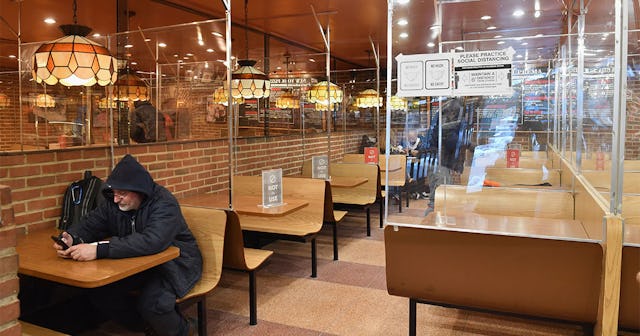Those Anti-COVID Plastic Barriers May Make Things Worse

The New York Times reports that the clear barriers do little to stop the spread of the coronavirus
The coronavirus sucks, y’all. After more than 15 months of public health protocols, the world continues to struggle with adjusting to a new normal. As schools and businesses contemplate reopening while the Delta variant sweeps across the nation, more and more organizations put dividers in place to help stop the spread of the highly contagious virus. Now, in news that will please no one, research suggests that barriers can interfere with normal ventilation.
Scientists who study aerosols, airflow and ventilation say that much of the time, the barriers don’t help and probably give people a false sense of security, reports The New York Times. Brace yourself: scientists say sometimes the barriers can make things worse.
According to the Times:
“Research suggests that in some instances, a barrier protecting a clerk behind a checkout counter may redirect the germs to another worker or customer. Rows of clear plastic shields, like those you might find in a nail salon or classroom, can also impede normal airflow and ventilation.”
When one person took to Twitter to take a dig at the ever-evolving nature of the study of COVID-19, another Twitter user clarified the matter.
Scientists explain that in areas without barriers, breath particles disperse and are replaced by fresh air roughly every 15 to 30 minutes. But placing plastic barriers around the room changes airflow in a room, disrupts normal ventilation and creates what scientists call ‘dead zones,’ which are places where air particles become highly concentrated.
“If you have a forest of barriers in a classroom, it’s going to interfere with proper ventilation of that room,” said Linsey Marr, professor of civil and environmental engineering at Virginia Tech and one of the world’s leading experts on viral transmission, tells the Times. “Everybody’s aerosols are going to be trapped and stuck there and building up, and they will end up spreading beyond your own desk.”
The science shows the barriers work on bigger droplets, like a sneeze or a cough. COVID however, spreads mainly through unseen aerosol particles. The Times article points to research in the U.S. and Britain that is…. unsettling:
“A Johns Hopkins study showed that desk screens in classrooms were associated with an increased risk of coronavirus infection. Researchers also found that plexiglass dividers with sidewalls in the main office were impeding air flow. And a study of schools in Georgia found that desk barriers had little effect on the spread of the coronavirus compared with ventilation improvements and masking.”
In a disturbing passage, Times referenced a study published in 2014 found that office cubicle dividers were among the factors that may have contributed to disease transmission during a tuberculosis outbreak in Australia.
Finally, the Times wrote about a British study:
“…[In] modeling studies simulating what happens when a person on one side of a barrier — like a customer in a store — exhales particles while speaking or coughing under various ventilation conditions. The screen is more effective when the person coughs, because the larger particles have greater momentum and hit the barrier. But when a person speaks, the screen doesn’t trap the exhaled particles — which just float around it. While the store clerk may avoid an immediate and direct hit, the particles are still in the room, posing a risk to the clerk and others who may inhale the contaminated air.”
It remains to be seen how organizations will implement this information in their workplaces, offices, and schools.